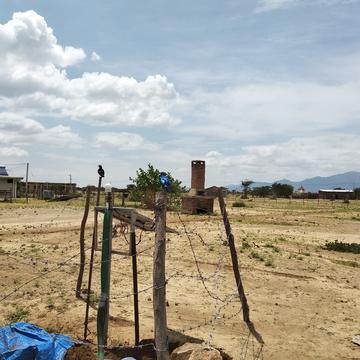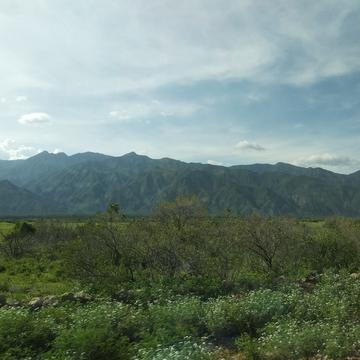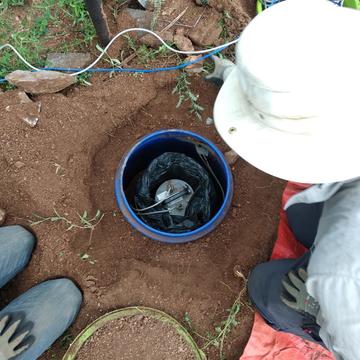The Mystery of the Turkana Depression

One of the seismic stations in the Turkana Depression
New research by Oxford Earth Sciences’ Dr Rita Kounoudis, published today in Nature, challenges long-held assumptions about what controls the strength of Earth’s outer shell (tectonic plates) and its susceptibility to continental break-up. The study shows that thin tectonic plates, stretched by past rifting, are actually stronger, not weaker, and fortified against future break-up. Using seismic waves to probe the subsurface of the Turkana Depression — a remote part of the East African Rift — the team discovered that the plate here remains surprisingly strong, despite being thin and sitting atop a hot mantle plume for millions of years.
How continents break apart
When upwellings of hot rock — known as mantle plumes — rise from deep within the Earth and interact with tectonic plates, the results are often dramatic: vast outpourings of magma form large volcanic provinces and even trigger continental break-up. Around 40 million years ago, one such mantle plume impacted the base of the African plate, producing enormous volumes of magma that built the “Ethiopian Traps” and set in motion the development of the East African Rift.
The Turkana Depression, which lies immediately to the south of the Ethiopian Traps, was also impacted by this mantle plume. By this point, however, Turkana had already endured an earlier episode of stretching around 60 million years ago — the Anza Rift — which thinned the plate but failed to split the continent apart.
Earth Scientists have long assumed that thin parts of a plate are weak and more likely to concentrate rifting and volcanic activity. However, this new study reveals the opposite is true: Turkana’s earlier failed rifting appears to have strengthened the plate, making it more resistant to extension and volcanism.
“Seismically speaking, the tectonic plate below the Turkana Depression looks nothing like the Ethiopian Plateau to the north, despite both being located above the same hot mantle plume. In fact, it behaves more like an area that hasn’t been affected by a plume at all. The rocks there are colder, stronger, and far more resistant to rifting and magmatism.”
- Dr Rita Kounoudis, lead author of the study.

Driving through the East African Rift Valley, which is bordered by mountain ranges, enroute to southern Ethiopia.
Peering below the surface
To delve deep into the structure of the crust and mantle below the Turkana Depression, the research team, which included geophysicists from the USA, UK, Kenya and Ethiopia, deployed a network of seismometers across Turkana (spanning southern Ethiopia and northern Kenya) as part of an NSF-NERC funded project. Beginning in 2019, the instruments recorded earthquakes that have occurred around the globe for about 2 years.
“We rose to the challenges of the COVID-19 pandemic as a collaborative international team to collect critical seismic and geodetic data. We were surprised to find that earthquakes and plate opening were absent beneath the older, failed rift zone.”
- Dr Martin Musila, recent PhD at Tulane University, USA
By tracking how the seismic waves travel through the crust and mantle – including how they reflect from and interact with subsurface boundaries such as the base of the plate — the team produced a detailed image of how seismic wavespeed varies with depth, reaching down to about 200 km. Comparing the results from Turkana with those from surrounding regions revealed striking differences. In Turkana, the plate appears as a cold, rigid lid overlying a hot, convecting mantle, with little evidence of magma intruding into the plate itself.
The researchers suggest that this unexpected behaviour is due to Turkana’s failed rifting 60 million years ago. When this stretching episode took place, small amounts of melting removed volatiles and weak mineral phases from deep within the plate, leaving it dry and strong, and therefore more resistant to future melting, fracturing, and rifting.

A seismometer, used to detect earthquakes, being buried in the ground during installation.
“Our findings suggest that once a rift fails, the process can actually harden the plate, making it less likely to break again. The challenge now is to apply what we’ve learned in East Africa to ancient rift systems around the world to better understand how continents have broken apart through geological time.”
- Dr Rita Kounoudis
Next, the team want to conduct some geodynamic modelling to incorporate these results, moving beyond the traditional view that a plate’s thickness is the primary control on its strength. The findings will also inform wider research which seeks to understand the formation of ancient Large Igneous Provinces (LIPs) and continental break-up worldwide.
The study “The importance of past rifting in large igneous province development” is available to read in the journal Nature at https://doi.org/10.1038/s41586-025-09668-7.
.




